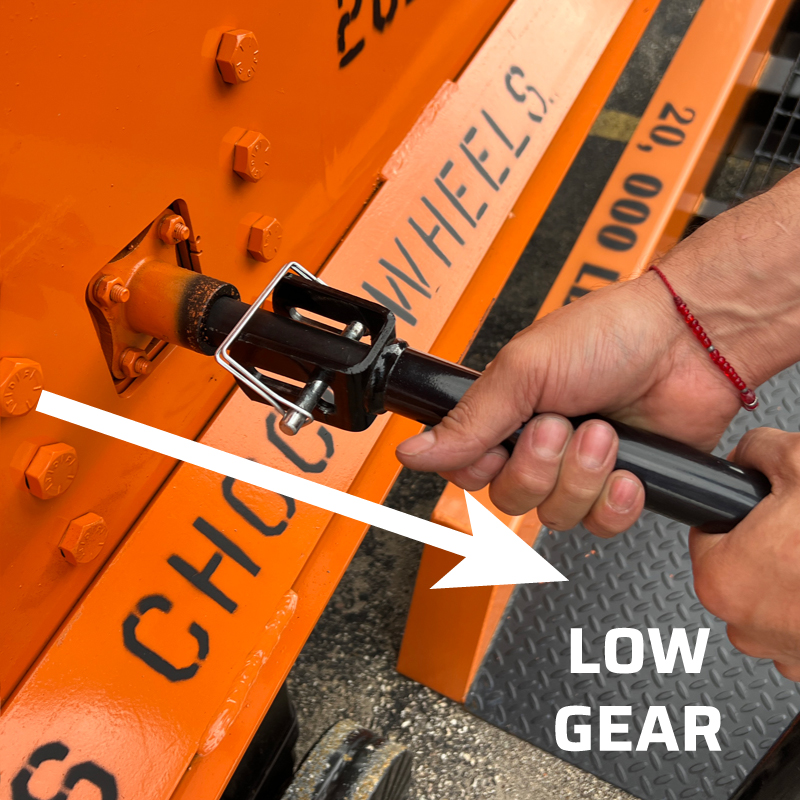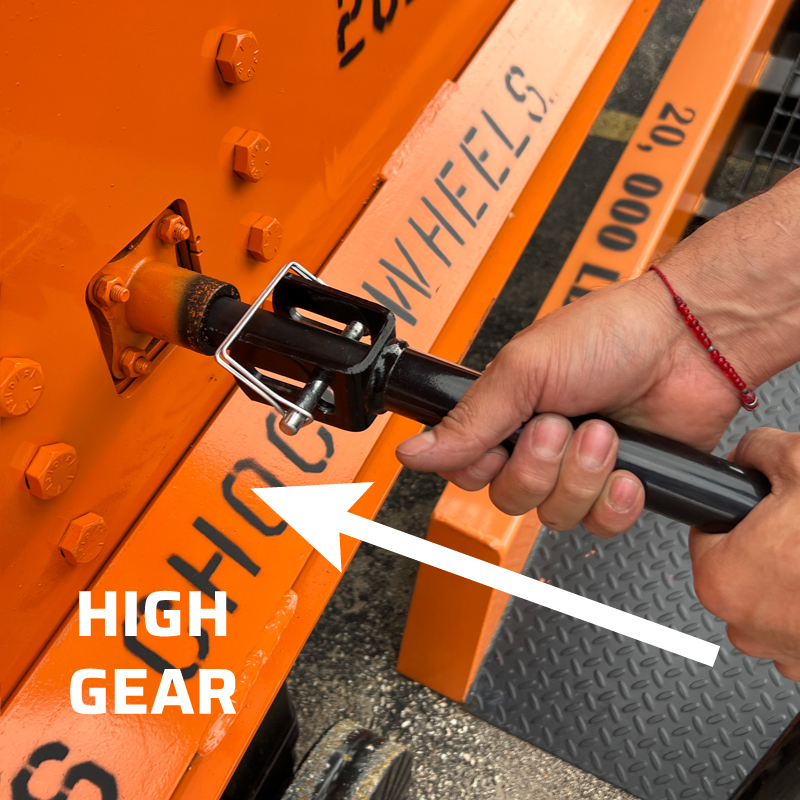Yard ramps, also known as portable loading docks or forklift ramps, play a crucial role in streamlining loading and unloading operations for businesses dealing with heavy equipment, merchandise, and other goods. The convenience and efficiency of yard ramps are well-recognized, but the debate between hydraulic and manual lift designs often arises. Because yard ramps sometimes service a variety of trucks and docks, they need to be able to adjust to differing heights. While hydraulic systems offer speed and automation, there are valid reasons why a manual crank would be an overall superior option for adjusting the height of a yard ramp. In this article, we’ll delve into the reasons why our yard ramps are fabricated exclusively with manual cranks and explain why we won’t sell you a ramp with a hydraulic pump.
How Do Hydraulic and Manual Crank Systems Work on Yard Ramps?
While both systems are effective at raising and lowering your yard ramp, each one functions quite differently. The operation of these systems helped us determine which is most ideal for use with yard ramps. Let’s dive into the basics of how each system works:
Hydraulic Systems
A typical hydraulic lifting system on a yard ramp consists of several key components: a hydraulic pump, a reservoir to hold hydraulic fluid, hydraulic lines or hoses, control valves, and a piston or hydraulic cylinder that does the actual lifting. To raise the yard ramp, an operator starts the hydraulic system by pumping a hand lever that drives the hydraulic pump. The pump draws hydraulic fluid from the reservoir and pressurizes it. The pressurized hydraulic fluid is then directed through the hydraulic lines to the hydraulic cylinder located beneath the ramp. The control valve is manipulated to direct the pressurized fluid into one side of the hydraulic cylinder, which causes the piston or rod inside the cylinder to extend. As the piston extends, it pushes against a mechanical linkage or directly against the ramp structure. This force causes the yard ramp to begin lifting. The ramp continues to rise as long as the hydraulic pump is running and pressurizing the fluid. While the actual usage of the hydraulic system is straightforward, the system itself is a bit complicated with a lot of moving parts.
Manual Crank Systems

A manual crank system, on the other hand, adjusts the height of a yard ramp manually through a gear set, without the need for external power sources like electricity or hydraulics. The manual crank system involves a set of gears and linkages that convert the rotational motion of the crank into vertical movement of the ramp.

These components are carefully designed to ensure that the force applied to the crank is translated into the desired upward or downward movement of the ramp. As you turn the crank handle, the gears engage and move the linkages, causing the ramp platform to rise or lower. The manual crank system allows you to control the rate and direction of movement by adjusting the speed and direction of your cranking.
So, why are Industrial Toolz yard ramps manufactured with a manual crank lifting system instead of a hydraulic one?
Why Our Yard Ramps are Manufactured with Two-Speed Manual Cranks
When perfecting the design and fabrication of our yard ramp, we wanted to ensure that it employed the best overall system to raise and lower the ramp. Through our extensive experience in the material handling and manufacturing industry, we’ve found that the manual two-speed crank is the best way to raise and lower a yard ramp. Let us explain why:
Drawbacks of Hydraulic Lifting Systems
While hydraulic lifting systems are effective in their purpose of raising and lowering a yard ramp, they still have some drawbacks when compared to manual crank systems.
Continual Maintenance
Hydraulic systems require regular maintenance to ensure consistent, safe operation. Continual maintenance is required to help prevent breakdowns, extend the lifespan of the equipment, and reduce the risk of accidents. The hydraulic system must be routinely inspected, and these inspections are quite extensive. Regular inspections and maintenance that must be performed on hydraulic systems include visual inspection of components, fluid checks and changes, fluid filtration, pressure checks, seal inspections, lubrication, alignment and balance checks, electrical system inspection, and operational testing. Because maintenance involves the management of hydraulic fluids, extra care and expertise must be taken to be sure the messy and potentially environmentally harmful fluid is handled correctly. This is why many manufacturers require the hydraulic system to be regularly serviced by a professional, which adds extra scheduling and cost to your business.
More Prone to Failure
Hydraulic systems are by their nature quite complex with a lot of moving parts. This means that there are a lot of different parts that can fail and need to be replaced. For example, if the capacity is exceeded on the yard ramp while the wheels are making contact with the ground there will likely be some hydraulic failure or seal leakage, leading to costly replacement or repairs and, most importantly, ramp downtime. Even if the ramp is used safely and correctly every time, hydraulic systems can still be prone to failure after consistent use.
Difficult & Expensive to Repair
Because hydraulic systems are more prone to failure, they are also more likely to need multiple repairs. These complicated systems are not easy to repair, even with a dense maintenance manual in hand. This is why many hydraulic lifting systems on yard ramps must be repaired by specialists. Not only is the repair expensive due to all the complicated parts of the system, but you likely must also pay someone else to fix it.
Benefits of the Two-Speed Manual Crank System
Manual crank systems have been relied on for millennia. Industrials Toolz has chosen to incorporate them as the lifting/lowering system for our yard ramps because of their ease of maintenance, reliability, durability, and fewer and easier repairs.
Ease of Maintenance
Because the system is not as complex as a hydraulic one, manual crank systems can operate virtually maintenance-free for years. The crank system only requires a little grease every 6 or so months to ensure its consistent usability. This straightforward maintenance does not need to be done by a specialist, saving you money on hiring a professional and avoiding ramp downtime.
Reliability & Durability
Simplicity translates to enhanced reliability. Yard ramps with manual crank lifting systems have fewer components that could fail, making them more dependable over the long term. Mechanical ramps are less likely to experience sudden breakdowns, reducing the risk of interruptions in loading and unloading operations that could impact business operations. This way you can focus on increasing the efficiency of your business operations instead of worrying about an unusable yard ramp slowing you down.
Fewer & Easier Repairs
The more simplistic design of the manual crank system translates into fewer and more straightforward repairs if ever needed. Because repairs usually entail disassembling and then reassembling the system, most business owners are able to perform the repairs themselves, saving costs on hiring a specialist. If replacement parts are needed to repair the crank system, they can be readily found and are not as expensive as the more complex hydraulic components.
Constructing the Ideal Yard Ramp for Your Business
While yard ramps with hydraulic lifting systems may have a slight advantage in terms of speed and physical exertion, the benefits of manual crank systems far surpass them. You’ve invested a lot into your business, so your yard ramp should protect that investment by being durable and reliable. Industrial Toolz’s yard ramps are designed and constructed with the efficiency and safety of your business in mind. Give our ramp experts a call at (262) 671-5000 to purchase or rent the ideal yard ramp for your business today!
